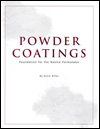Thermal Stabilization of Powder Coatings
An Ongoing Study of Various Formulating Options

Powder coating technology is commonly described as the art of applying a pulverized resin to a substrate and heating the powder so that it melts and creates an even coating on the substrate. This simple technology can be very successful in providing impact, corrosion and abrasion resistance, as well as ensuring gloss retention and surface protection. In short, powder coatings are durable. They are also chosen for their versatility and savings potential. Powder coating technologies are nowadays seen as a sustainable option, in particular for industrial coating applications. While they are most widely used to coat metal substrates, numerous efforts have been put into developing solutions that allow their application to more highly temperature-sensitive materials such as wood and plastics. New opportunities for powder-coating-based technologies are arising as a result of expansion and growth in construction markets, and through increasing demand for more sustainable solutions. Raw material suppliers and coating formulators are responding with the development of new powder coating technologies that can be produced and applied more efficiently, exhibit improved performance, and have a greater range of potential end uses.
A typical powder coating formulation contains ingredients ranging from binders, fillers, pigments and crosslinkers to various types of additives. The combination of components and their fine tuning at different ratios allow the final powder and coating properties to be determined once the coating is applied. The ingredients are dry-mixed, fed into an extruder and heated to produce a homogeneous mixture. The heat involved in the melting/extrusion process is not high enough to induce a reaction or to initiate curing. The mass produced during this melting/extrusion process is pushed through chilled rollers, flattened, fed onto a belt to cool down, and then shaken at the end of the belt so that the hardened material breaks into small pieces. Afterwards, the material is reshaped to the required size and sieved, and is then ready to be packaged and shipped out or stored. Powder coatings differ from other types of coatings in that they are solid at ambient temperature, and they melt quickly to become low-viscosity mixtures that can form a continuous film. This 100% film-forming mixture completely covers the substrate or the part to be powder coated. The uniform coating provides superior durability and aesthetic appeal, and further fine tuning of the formulations allows customers’ specific color and performance needs to be met.
Formulations are sometimes adjusted by fine tuning various additives, including antioxidants and light stabilizers, which provide different thermal and light stabilization properties. Powder coating performance is improved by these types of additives, which are used to enhance specific properties. They help to prevent discoloration during powder coating resin production and curing, to ensure homogeneous and more efficient spraying of the powder onto the substrate, to impart greater durability to the coating through light stabilization, and to improve corrosion resistance.
It is very important to find the best combination of additives to achieve the necessary performance, especially if the final substrate or area to be powder coated requires specific durability or heat resistance. A more detailed analysis of the various antioxidants for powder coating technologies has been started at SONGWON’s Technology Innovation Center in Maeam, South Korea, with the aim of better understanding how the different antioxidant functionalities influence final performance.
Better Understanding Antioxidants
Antioxidants act as heat stabilizers. They need to be thermally stable and withstand high-temperature powder extrusion and curing processes. Another important property is color retention. Antioxidants are normally added in several stages at different points throughout the process, from resin synthesis to powder extrusion. The resin manufacturer aims to achieve basic stabilization during synthesis with standard antioxidants and process stabilizers. Most powder coating formulations need to be fine tuned to achieve further stabilization during extrusion and curing. It is therefore essential for powder coating formulators to understand how a given antioxidant package will perform.
The current study is based on a completely standard PES/Primid® resin system; other types of binders are also going to be tested and studied. Antioxidants are chosen among various types — phenolic, phosphite and thioester. Stabilized powder coatings formulations are then cured at temperatures up to 170 °C-180 °C, depending on the conditions set by the resin producers, and subsequently overbaked at various temperatures up to 240 °C for different periods of up to several hours. Discoloration properties are measured and evaluated using the Yellowness Index and Whiteness Index in accordance with standard E313 D65/10. Given the overall temperatures involved in the extrusion and curing processes, phosphite antioxidants are often the best choice for achieving the required heat stabilization with powder coatings. In addition, as a simple rule of thumb, we often advise customers to follow the guidelines below on heat stabilization of antioxidants if they are used as a single additive:
Phosphite > Thioster > Phenolic
In the study currently in progress in our coating laboratory at the Technology Innovation Center, we are focusing on testing the synergistic effects of combining the various functionalities (phenolic, phosphite and thioester), with the aim of achieving optimal heat stabilization performance. In the majority of cases, the results indicate that synergistic combinations of the various antioxidants are highly beneficial, and allow the durability and thermal stability of the coated materials to be significantly enhanced. Several stabilization packages (combinations of different stabilizers in various ratios) have been prepared and given to various customers to be tested in their facilities by their own testing methods and according to their requirements. Once completed, the results will be presented and shared with the technical communities.
Looking for a reprint of this article?
From high-res PDFs to custom plaques, order your copy today!








